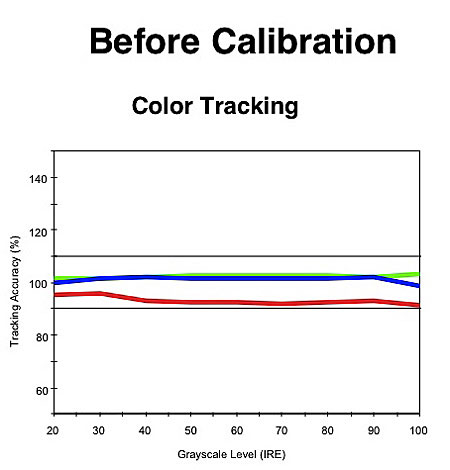Marantz VP-15S1 DLP Video Projector Added Measurements by Thomas J. Norton
Settings
The settings I used for the primary color temperature calibrations and other measurements were somewhat different than those Shane Buettner used for most of his viewing, in order to obtain a brightness level I found sufficient. However, results are also included here for several different setups. My screen is virtually identical to Shane's—a 78" wide, 16:9, Stewart Studiotek (gain 1.3).
The two main issues with the higher contrast setting I used was a slight trace of pink in some levels of a 10-step grayscale pattern (which did not affect the color temperature readings or the quality of the picture with normal program material), and some clipping above 100IRE. This did not appear to have any adverse effect on the picture.
The primary settings I used for most of the results shown below, except as noted, were:
Gamma: Standard
Contrast: +15
Brightness: -13
Sharpness: 0
Lamp: Normal
Iris: 2
Color temperature: 3
White Balance (after calibration)
Red gain: 12, Red bias: -3, Green bias: -1, Blue bias: -1
Others: 0
Component Video Resolution
The component luma (B&W) and chroma (color) response at the maximum burst frequency (37.1MHz for luma) of my AccuPel test pattern generator were good at 1080i, though the luma response, while clean, did show significant rolloff at this frequency (typical of many good projectors). At 720p, the top-end component response was slightly more rolled off in both luma and chroma, but still usable. The 480p luma and chroma responses were also good, as was the 480i luma, but the 480i chroma response disappeared at the maximum burst frequency.
In component, the 1080i responses (both luma and chroma) were satisfactory to the top burst, but rolled off slightly more than in HDMI. 720p luma response remained about the same as in HDMI, while the 720p chroma response was actually significantly better than in HDMI. Both 480i and 480p were marginal at the maximum frequency, but nevertheless better than their HDMI performance.
Color
In the number 3 color temperature setting, with the bias and gain calibration controls zeroed out, the Marantz' pre-calibration color temperature was relatively uniform across the brightness range, though at around 7000K a bit on the cool side (Fig.1). Calibration brought the result very close to optimum across the full brightness range (Fig.2).

Fig.1

Fig.2
Figs.3 and 4 show that the color tracking was short on red before calibration, but superb afterward.

Fig.3

Fig.4
The Marantz' color space (Fig.5) indicates significant oversaturation in both red and green.

Fig.5
Contrast and Overscan
In the settings shown above, I measured peak contrast ratio of 2206:1 (11.03 foot-Lamberts peak white, 0.005fL video black). Dropping the Contrast setting to zero (midpoint) but keeping the other settings unchanged, produced a peak contrast ratio of 1700:1 (8.5fL peak white, 0.005 video black).
I also tried other options, re-setting the brightness control for the correct setting each time (the changes were minor). Opening up the iris all the way (a setting of 3), changing the lamp to Economy mode, and setting Contrast on +15 resulted in a peak contrast ratio of 1562:1 (18.74fL peak white, 0.012 video black). (Incidentally, the projector is much quieter in Economy than in Normal.)
Closing the iris down to 1, with the Contrast on zero and in Normal lamp mode produced a contrast ratio of 2463:1, with an impressive black level of 0.003 but a not so good impressive peak white level of 7.39fL.
But if you really want to push it, with a Contrast setting of +15, the lamp on Normal, the iris wide open at 3, and the gamma on Dynamic I squeezed a maximum light output of 25.87fL from the Marantz on my screen. The video black level with these settings was 0.014fL, for a peak contrast ratio of 1848:1. This would be useful mainly on a larger screen (or a lower gain screen such as the Steward Grayhawk), which would reduce both the peak white output and lower the black level. (Gamma should affect only the mid brightness region, but in the Marantz the Dynamic gamma mode added about 20% to the peak white output.)
The projector's overscan, in both component and HDMI, was zero for both 1080i and 720p, and averaged just under 2.5% (a maximum of 3%) at 480i and 480p.
- Log in or register to post comments




































































